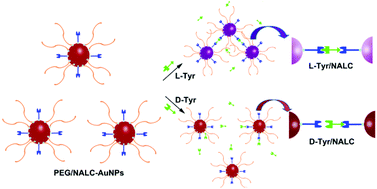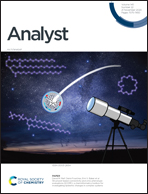PEGylated NALC-functionalized gold nanoparticles for colorimetric discrimination of chiral tyrosine
Abstract
In this work, acid and matrix-tolerant multifunctionalized gold nanoparticles (AuNPs) with an integrated chiral selector towards tyrosine (Tyr) and polyethylenglycol (PEG) chains were developed for visual chiral discrimination of Tyr in biological samples under acid conditions. In brief, AuNPs multifunctionalized with N-acetyl-L-cysteine (NALC) and PEG (PEG/NALC-AuNPs) were prepared via a simple strategy. In the presence of L-Tyr, the color of PEG/NALC-AuNP solution changed from red to gray, while no obvious color change was observed with the introduction of D-Tyr, which indicated that the introduction of PEG onto the surface of AuNPs has no effect on the chiral recognition between L-Tyr and NALC. A computer-aided molecular model was used to clarify the chiral recognition mechanism between NALC and Tyr enantiomers and to further guide the optimization of sensitivity. The resultant PEG/NALC-AuNP sensor presented a significantly improved stability under acid and alkali conditions compared with conventional NALC-AuNPs, resulting in a wider dynamic range (500 nM–100 μM) and a 50 times reduced detection limit by simply adjusting the pH of the sensor system under acid conditions (pH 2–2.5). More importantly, the PEG/NALC-AuNPs can realize the visual chiral discrimination of Tyr enantiomers in biological samples due to their significantly improved long-term stability and reduced interaction towards non-target species.



 Please wait while we load your content...
Please wait while we load your content...